Plants such as marigolds (Tagetes) are annuals or perennials and belong to the Asteraceae or Asteraceae family. Marigolds come from Central and South America. Local Indian tribes have used them in their rituals for a long time, and these plants were also used for medicinal purposes. Marigolds appeared in Europe in the 16th century, and they also became the first flowers brought to Russia from overseas countries. The name of this plant was given by K. Linnaeus. He named him after the Etruscan demigod Tages, the grandson of Jupiter, who was very handsome and possessed the gift of a diviner. Marigolds are popularly called blackbears. This genus unites about 40 species, which are happily grown in different parts of the planet Earth.
Content
Features of marigolds
Branched or erect shoots form a bush 20-130 centimeters high. Fibrous root system, there are pinnately dissected or pinnately divided leaf plates, which are alternately or oppositely located. The color of the leaf plates is from dark to pale green. Flower baskets can be painted in a variety of shades of brown, yellow and orange. The marginal flowers are pseudo-lingual, and the median ones are bisexual, tubular, there are 5 stamens. The pistils have a pair of stigmas, and the ovary is lower. Abundant flowering, begins in the first days of June, and ends with the onset of the first frost. The fruit is a linear achene. These plants are capable of producing abundant self-seeding. At the same time, seed germination is able to persist for 3 to 4 years. The plants give off a strong spicy aroma, with the leaf plates smelling much stronger than the flowers.
Properties of marigolds
Marigolds have long been used for medicinal purposes. They have been carefully researched by scientists, and they have confirmed that these flowers really have healing properties. In this regard, marigolds can not only decorate your garden, but also heal various diseases. So, the lutein contained in them will help to avoid the development of cataracts. This plant is also able to help with inflammation of the pancreas, as well as diabetes.An infusion made from dried marigolds is used in the treatment of bronchitis, colds, stomatitis, asthma, and it also purifies the blood. To make an infusion, you need to mix 1 large spoonful of chopped flowers with 1 liter of freshly boiled water. After 3 hours, the infusion must be filtered. Drink it in 200 g 30 minutes before meals for 4 weeks.
With neuroses and depression, experts recommend taking baths, into which a decoction of marigolds is poured, as it helps relieve stress, normalizes the nervous system, and eliminates anxiety. And for a long time, the peoples inhabiting South America have used these plants as food, as well as a seasoning, and also for making marinades, sauces and various pastries. In the Caucasian markets, you can buy marigold powder, which is called "Imeretian saffron", it is seasoned with satsivi, pilaf and soups. In France, these flowers are grown on an industrial scale, as they are in great demand among gourmets. If you put the leaves of such a plant in the marinade, then the vegetables will smell very nice, and they will retain their elasticity for a long time.
You can also make delicious cookies with marigolds. To do this, you need to separate 4 proteins and beat them well to form a foam. Combine 100 grams of granulated sugar with 2 large spoons of fresh flower petals of such a plant and grind everything thoroughly. 4 large tablespoons of cow oil must be continuously rubbed, combined with the remaining yolks, with granulated sugar mixed with marigolds, and with 100 grams of wheat flour. After that, on top of the resulting mass, you need to very carefully lay out the proteins and gently mix everything slowly. Grease a baking sheet with oil and place the dough in it. The cake needs to be baked until fully cooked, until its surface acquires a golden hue. When the resulting cake becomes cold, it must be divided into squares with a knife.


Watch this video on YouTube
The main types and varieties with photos and names
A large number of different types of marigolds are cultivated by gardeners, but the most popular are varieties of only 3 species, namely: rejected (undersized), erect (most often high) and thin-leaved (rarely found in mid-latitudes). The varieties of these species are distinguished by their diversity. So, their flowers can be large or small, double or double, and painted in various shades of orange, brown and yellow.
Erect marigolds (Tagetes erecta), or African
In this genus, they are giants, so their height can reach 0.3-1 meters. Most often, terry inflorescences are painted in one color shade, while their diameter does not exceed 15 centimeters.
Popular varieties:
- Vanilla - the height of the bush is up to 0.7 m, the diameter of the terry white-cream inflorescences reaches 12 centimeters.
- Kilimanjaro - bush height 0.6-0.7 m, densely double inflorescences have a spherical shape.
- Antigua - undersized variety, the height of the bush is no more than 25 centimeters. The bushes are erect, and they have large (about 15 centimeters in diameter) flowers painted in a yellow-lemon, deep yellow, golden or orange hue.
Marigolds undersized, or rejected, or French (Tagetes patula)
The height of the bushes is most often below 0.6 m. On compact bushes there are a large number of non-double and double inflorescences, the diameter of which is most often no more than 8 centimeters. This type is also called sprawling. The most popular varieties are included in the Bonanza series, the height of which does not exceed 30 centimeters, for example, Bonanza Bolero, Bonanza Orange, Bonanza Flame, etc. Their bushes with terry small (diameter about 5-6 centimeters) inflorescences painted in saturated colors, look very impressive. Carmen marigolds are also highly decorative. Their inflorescences, which are terry, consist of corrugated petals.The petals in the central part are colored yellow-orange, and brown-red at the edges.
Tagetes thin-leaved, or Mexican
They look very different from other species. So, they have fragrant openwork-lace leaf plates that seem to float in the air. And they also have a huge number of small inflorescences, which creates the effect of sparkling fireworks. They can be tinted yellow-gold, orange-red and orange-gold. They have been cultivated since 1795. Today there are about 70 varieties of this species. The height of the bushes does not exceed 40 centimeters. Their root system is very powerful, and there are also adventitious roots at the bottom of the shoots. The most popular varieties are Ursula (orange-golden), Golden Jam, Gnome, Lulu (yellow-golden), Paprika (orange-red).
Growing marigolds from seeds
Sowing seeds in open ground
Even a beginner can handle the cultivation of marigolds from seeds. In open ground, you can sow both seeds and plant an already flowering bush. Planting seedlings or sowing seeds should be done after the soil is well warmed up. It is necessary to make a groove with a chopper, which will have a five-centimeter depth. Water it, and then put the seeds in it. After that, the groove must be covered with soil. After half a month, the first seedlings will appear. If the seedlings are too dense, then they need to be planted.
Growing through seedlings
You will have to buy marigold seeds only for the first sowing. The fact is that after the plants you have grown have faded, you can collect a large number of seeds. To do this, wait until the inflorescences dry well, and remove the seeds from them on a not rainy day. They should be dried and stored until next spring. However, it should be borne in mind that there are a large number of hybrids on sale, and the seeds collected from such bushes may not retain varietal properties, in this case they inherit the characteristics of any one of the parent plants. Most experienced gardeners prefer to sow seeds that have already sprouted. Cover the bottom of the saucer with a damp cloth and place the seeds on top of it. Then the saucer should be placed in a plastic bag and put away in a warm place. After three days, the seeds will hatch.
At what time to sow seedlings
When choosing a sowing date, it should be borne in mind that the earlier you sow the seeds, the faster you will see the flowers. When growing various species, it should be borne in mind that small-leaved and low-growing ones are recommended to be sown in the first days of April, and erect ones - in mid-March. In this case, all these bushes will bloom at the same time - in June. Growing seedlings is quite simple, but still there are several nuances. Prepare a soil mixture, for this combine peat, sand, humus and sod (2: 1: 2: 2). Then it must be disinfected with a solution of a fungicidal agent or manganese potassium (dark pink color). Make a three-centimeter drainage layer of sand, gravel or expanded clay at the bottom of the container. Fertilize the substrate by adding organic fertilizers (fresh manure cannot be used). Make grooves, while the distance between them should be 15–20 mm. Place the seeds in them and cover the grooves with a thin layer of the substrate. Watering must be done very carefully, as the seeds can be easily washed. Place the container in a warm place (22 to 25 degrees) and moisturize the soil in a timely manner without letting it dry out. The first shoots should appear after 7 days, after which the container must be rearranged in a well-lit place in which the air temperature is 15-18 degrees.
What time to plant seedlings
Planting seedlings in open soil is carried out only after there is no threat of frost. Remember that marigolds are afraid of frost. It should also be remembered that the planted marigolds should have 3 true leaves, as well as a powerful root system. As a rule, disembarkation takes place in the last days of May, the first in June.For planting, you should choose a site with soil saturated with nutrients, loamy, neutral, which is well moistened from the beginning to mid-summer. In the event that the soil is infertile, then the plants during the period of active growth will need to be fed 2 or 3 times.
The distance between the bushes directly depends on the species and variety. If the plants are undersized, then a distance of 20 centimeters must be maintained between the bushes and rows, for medium-sized ones it is 30 centimeters, and for tall ones - 40 centimeters. After the seedlings are planted, they need to be watered often enough and well. Despite the fact that marigolds are resistant to drought, if they are watered rarely and poorly, then the bushes will be puny, and the flowers will be small.


Watch this video on YouTube
Marigold care
These plants prefer to grow in sunny areas, and it is in such a place that their flowering is most abundant and spectacular. You can also grow such a flower in partial shade and shade. While the flower is actively growing, it should be watered regularly and abundantly, but after the formation of inflorescences begins, watering must be reduced, because otherwise, due to stagnant moisture in the soil, the roots may rot, and this also leads to a lack of flowering. You need to feed the marigolds at will, while keeping in mind that they respond extremely positively to feeding. For this, a complex fertilizer is used. The first feeding is carried out when the plant reaches ten centimeters in height, the second time - at the beginning of budding, and the third time - when the plant blooms.
These colors need frequent weeding and loosening of the soil surface. In the event that the bushes grow in the summer, formative pruning can be done. If inflorescences that have begun to fade are removed in time, the abundance of flowering will increase. The strong smell emanating from the plant, as well as the phytoncides included in its composition, protect marigolds, as well as flowers growing in the neighborhood, from fungal diseases. Very often, experienced gardeners plant marigolds along the edge of the entire plot. If a damp rainy summer comes out, then slugs or snails can harm the marigolds. In order to drive away such pests, it is recommended to place jars filled with bleach between the bushes. In rare cases, gray rot may form on foliage and shoots. Those bushes that are infected must be dug up and burned, as they can infect other plants. If in the summer there are prolonged droughts, then very often a spider mite settles on marigolds. In order to get rid of it, it is recommended to use an infusion of yarrow, onion or red hot pepper. For preventive purposes, in dry times, the bushes must be moistened from a spray bottle several times a day.
Marigolds after flowering
Decorative marigolds are most often annuals. In this regard, after flowering, they must be pulled out. In order to enjoy the beauty of marigolds for the next year, it is necessary to collect ripe seeds in time.
Dry inflorescences can be used both on the farm and for medicinal purposes. For example, if you work at a computer for a long time, it is recommended that each time before eating, eat 2 or 3 small heads of such a flower, and they can also be added to a salad.
If there are pinworms or roundworms, it is necessary for 7 days in the evening to eat several heads of marigolds (for children - 2 or 3 pieces, for adults 5 pieces each).
To get rid of midges flying near the compost pit, you need to pour a full bucket of dried marigolds into it.
If a bouquet of marigolds is placed on the window located near the front door, then guests with ill intentions will pass by.
Healthy recipes
- Lip balmto make it softer. Grind the heads of such a plant and take 2 large spoons of the resulting raw material. Combine them with 1 large spoonful of apricot oil and a third cup of olive oil. Remove the mixture to a shaded area for 7 days.After that, it must be filtered, and do not forget to squeeze the marigolds thoroughly. The resulting product should be smeared on the skin of the lips, if necessary.
- Facial lotion... Take a couple of large spoons of crushed plant heads and mix them with 200 g of freshly boiled water. Let stand overnight. Then the infusion must be filtered, while squeezing the marigolds. Pour into the resulting infusion 1 small spoonful of lemon juice and 1 large spoonful of vodka. For storage, the product must be placed on a refrigerator shelf. Wipe your face 3 times a day.
- A remedy for prickly heat, for irritation or inflammation of the epidermis of the face. Take a couple of large spoons of chopped marigold inflorescences and mix them with 300 g of hot water. Let the mixture boil, cover and leave for about 3-4 hours. Strain the broth, while squeezing the flowers. Add a couple of large tablespoons of water and the juice squeezed from a large aloe leaf. For storage, the product must be placed on the shelf of the refrigerator. They need to process the inflamed areas 2 times a day.

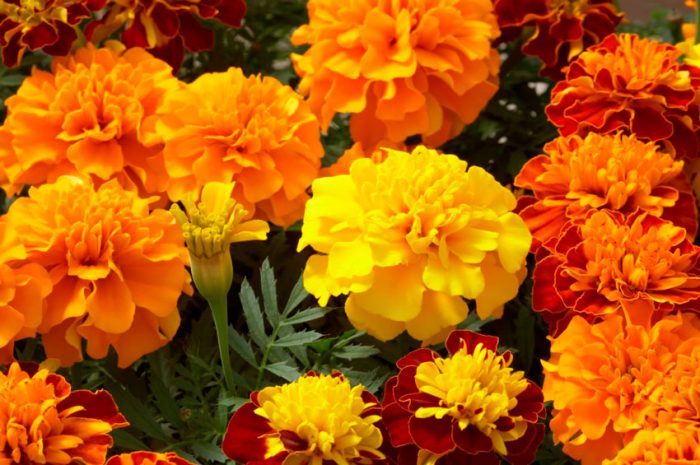
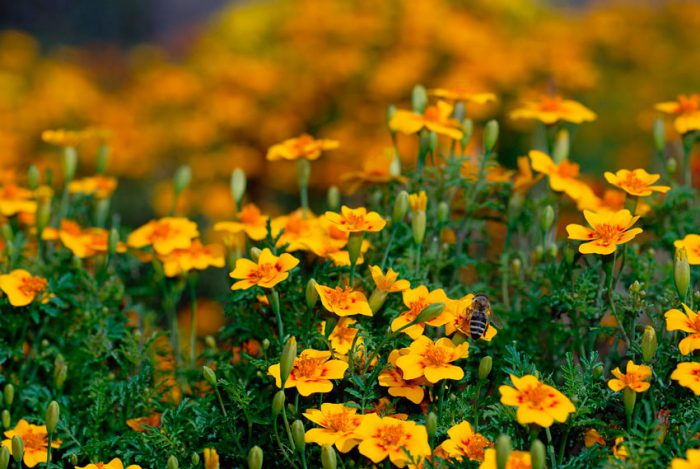
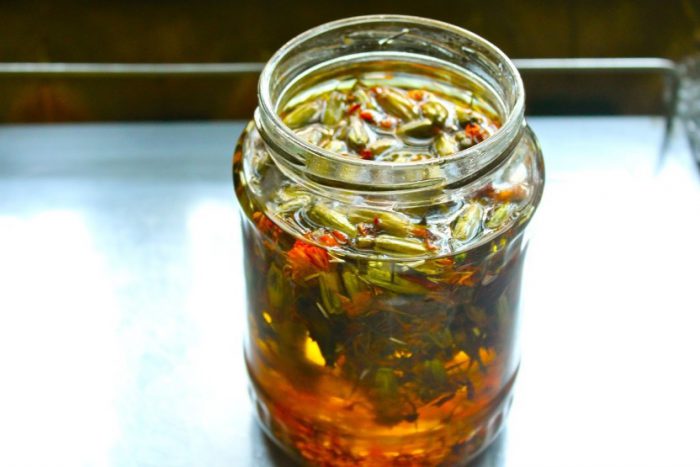
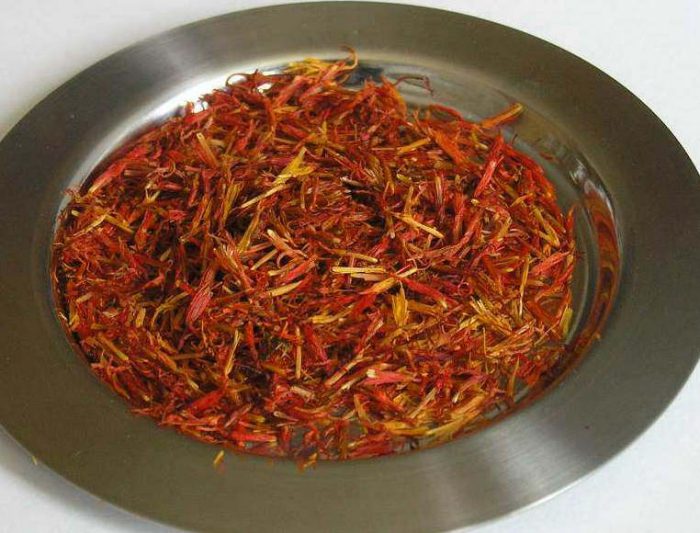
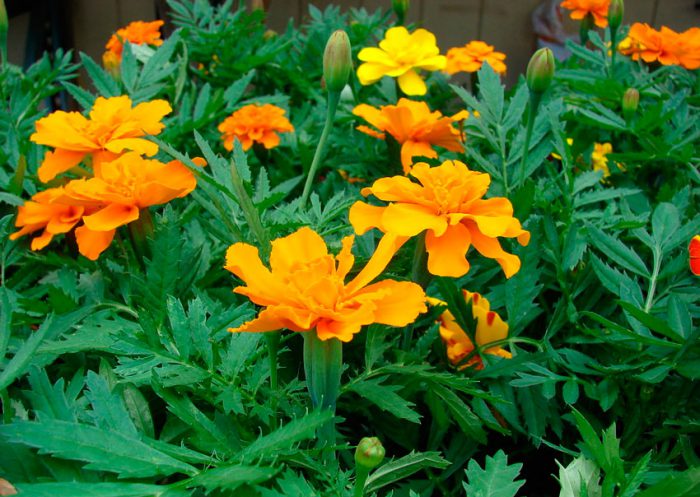

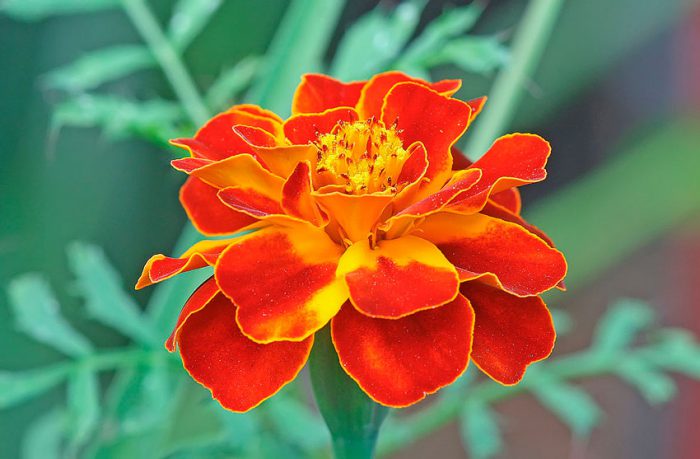
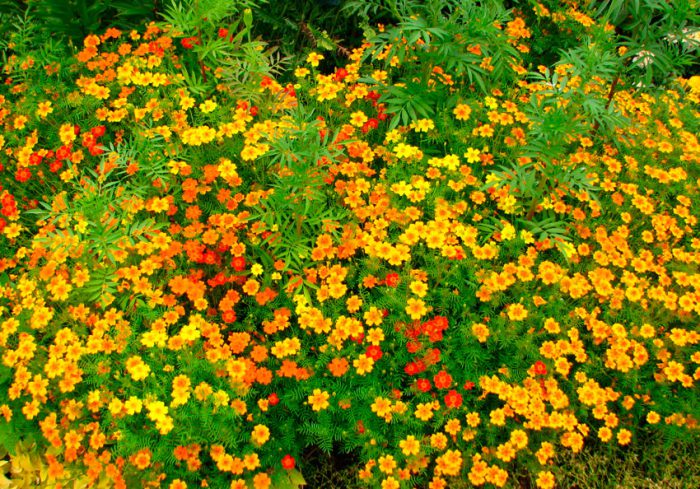
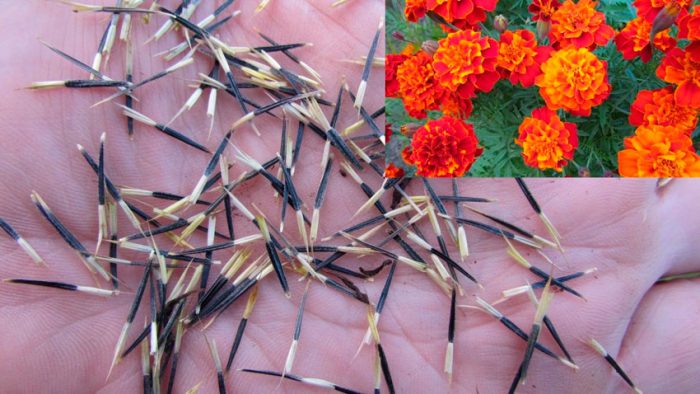
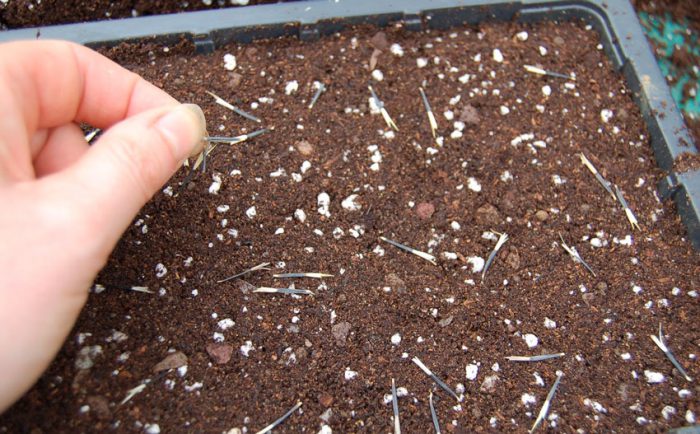
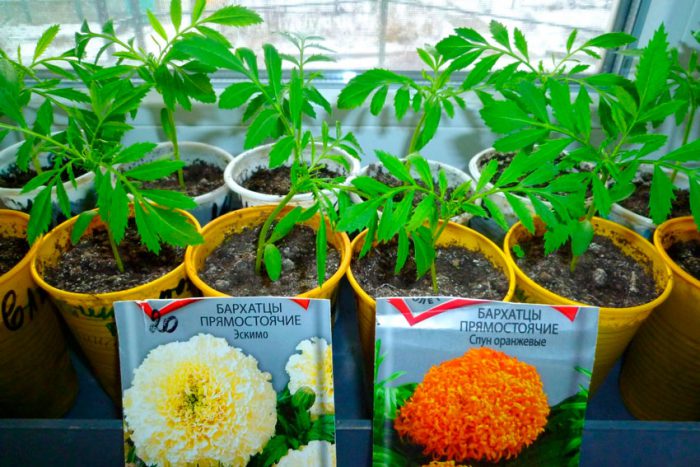

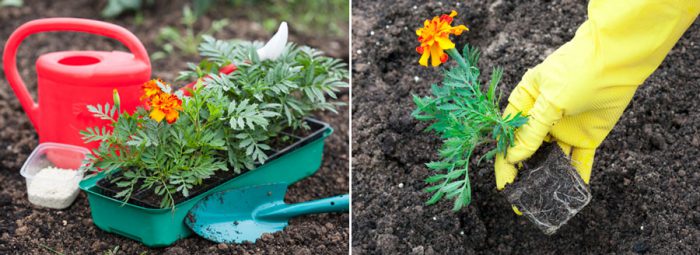

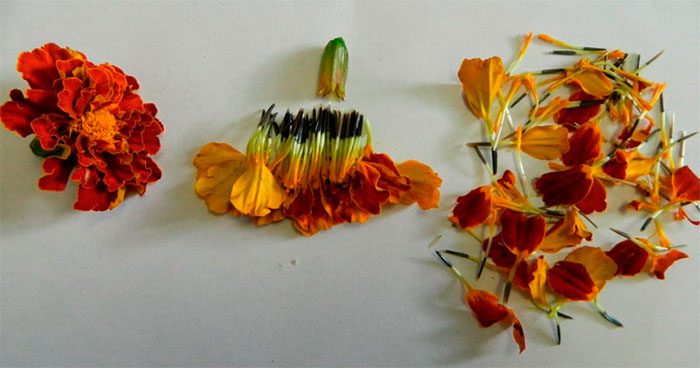











Good day! I really love marigolds, but I couldn't get seedlings. Now I understand why. I found a very good and simple article about growing marigolds, last year I was the first year with my seedlings. This year I will also do it.